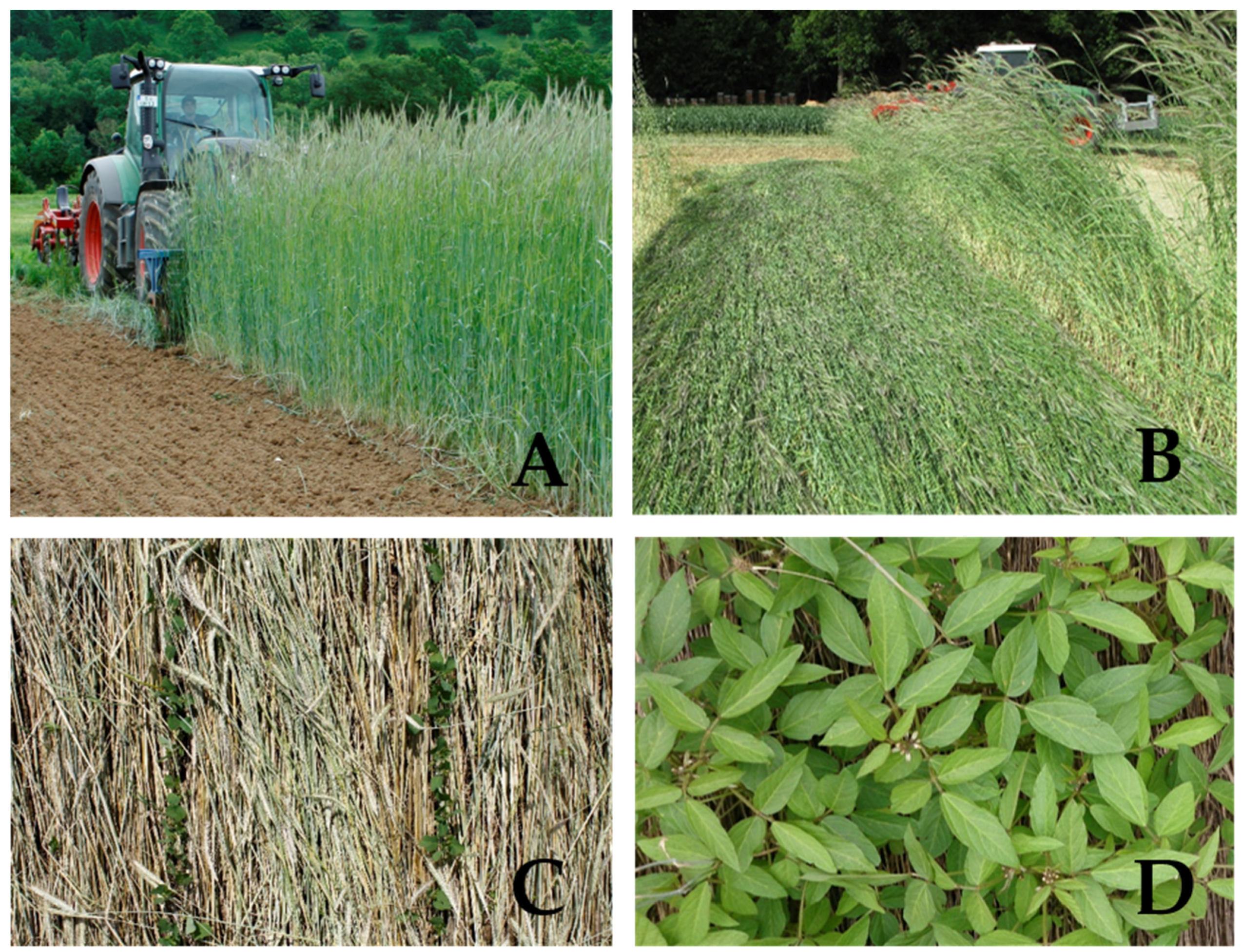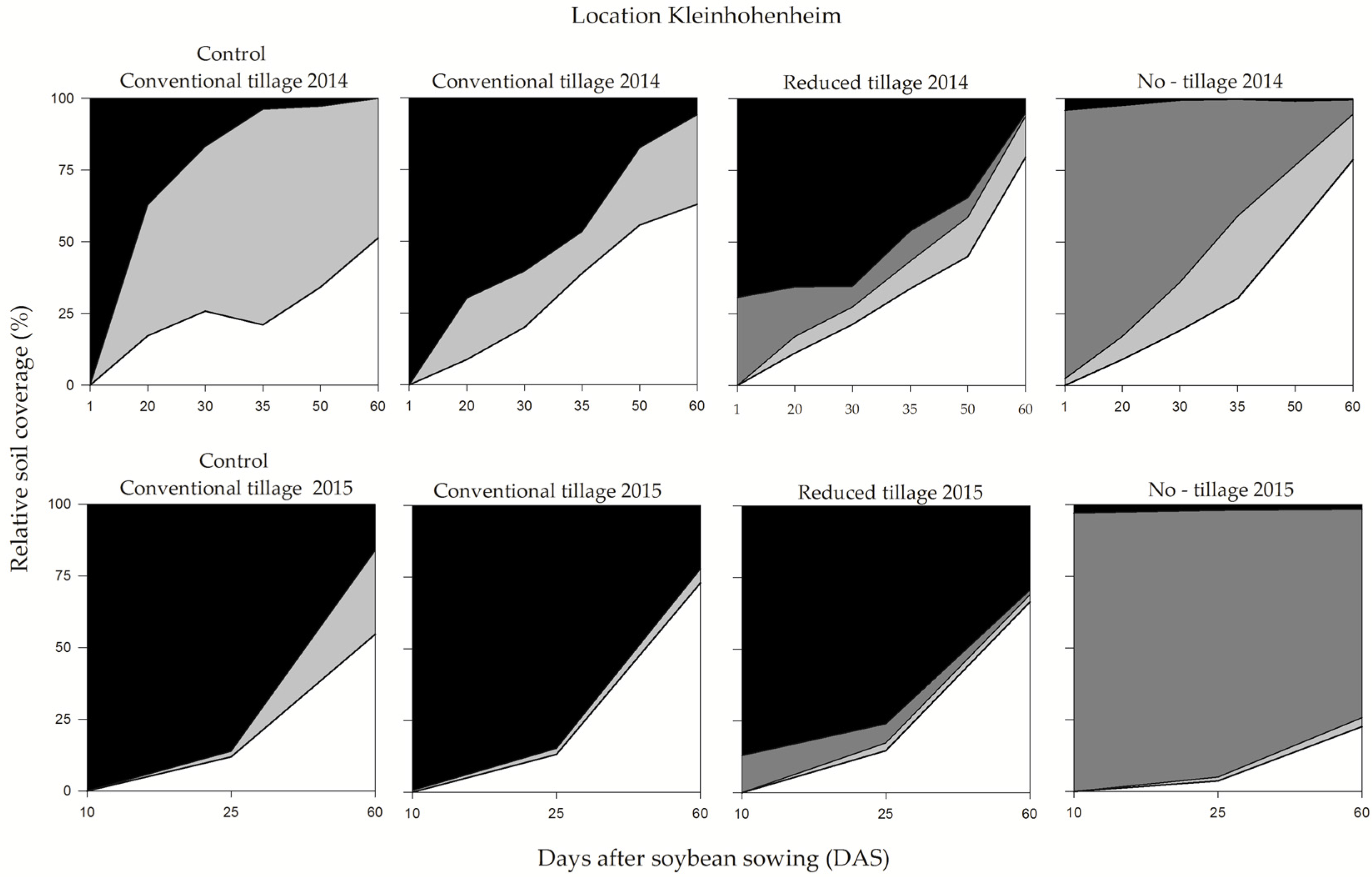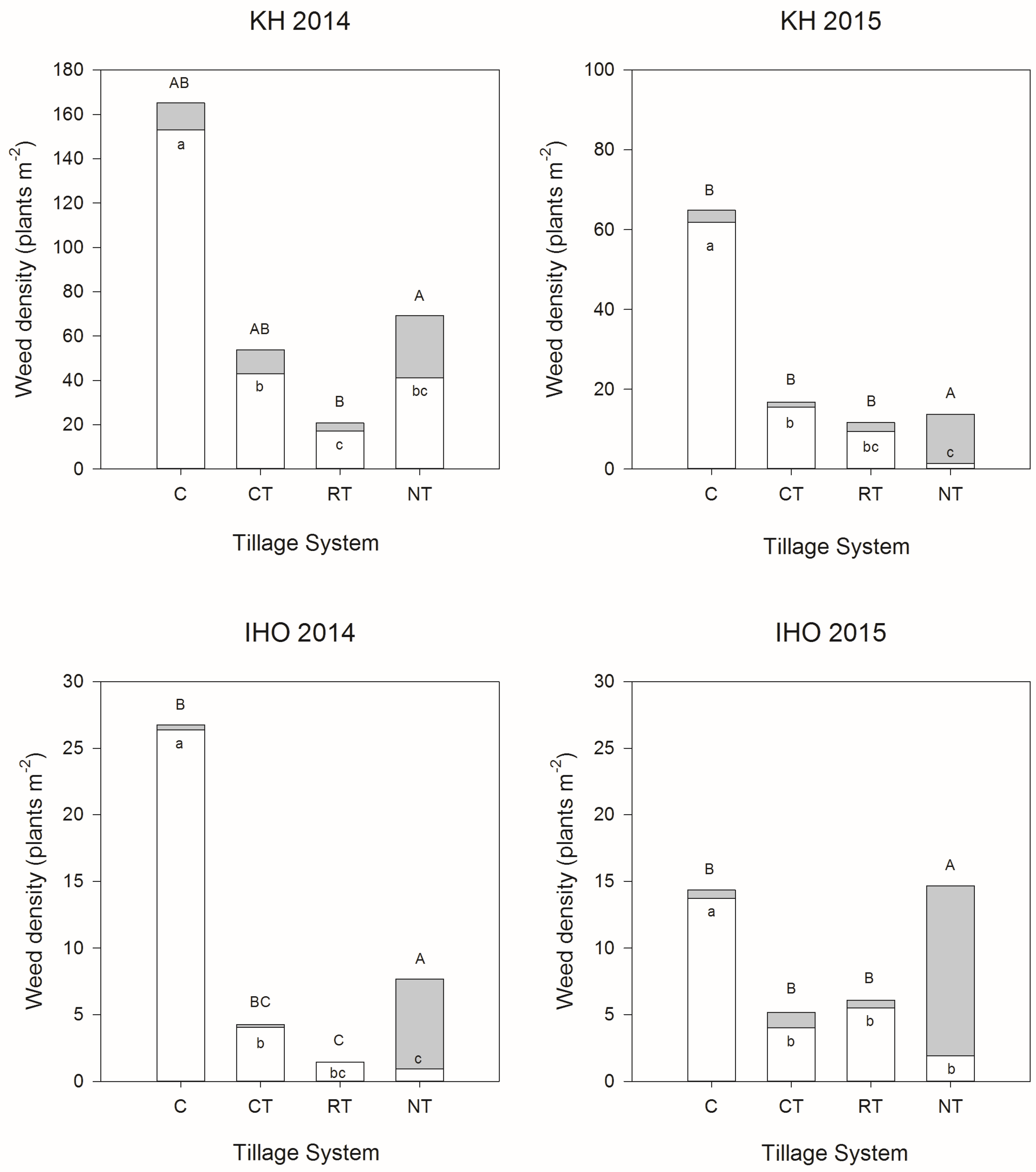Weed Control Using Conventional Tillage, Reduced Tillage, No-Tillage, and Cover Crops in Organic Soybean
Abstract
:1. Introduction
2. Materials and Methods
2.1. Experimental Sites
2.2. Data Collection
2.3. Statistical Analysis
3. Results and Discussion
3.1. Soil Cover
3.1.1. Trial Kleinhohenheim
3.1.2. Trial Ihinger Hof
3.2. Weed Density
3.3. Soybean Plant Density and Yield
4. Conclusions
Acknowledgments
Author Contributions
Conflicts of Interest
References
- Swanton, C.J.; Weise, S.F. Integrated Weed Management: The Rationale and Approach. Weed Technol. 1991, 5, 657–663. [Google Scholar]
- Lal, R. Enhancing ecosystem services with no-till. Renew. Agric. Food Syst. 2013, 28, 102–114. [Google Scholar] [CrossRef]
- Lal, R. The Plow and Agricultural Sustainability. J. Sustain. Agric. 2009, 33, 66–84. [Google Scholar] [CrossRef]
- Scopel, A.L.; Ballare, C.L.; Sànchez, R.A. Induction of extreme light sensitivity in buried weed seeds and its role in the perception of soil cultivations. Plant Cell Environ. 1991, 14, 501–508. [Google Scholar] [CrossRef]
- Jacobsen, B.H.; Ørum, J.E. Farm economic and environmental effects of reduced tillage. Acta Agric. Scand. Sect. C Food Econ. 2009, 6, 134–142. [Google Scholar] [CrossRef]
- Melander, B.; Munier-Jolain, N.; Charles, R.; Wirth, J.; Schwarz, J.; van der Weide, R.; Bonin, L.; Jensen, P.K.; Kudsk, P. European Perspectives on the Adoption of Nonchemical Weed Management in Reduced-Tillage Systems for Arable Crops. Weed Technol. 2013, 27, 231–240. [Google Scholar] [CrossRef]
- Triplett, G.B.; Dick, W.A. No-tillage crop production: A revolution in agriculture! Agron. J. 2008, 100, 153–165. [Google Scholar] [CrossRef]
- Zikeli, S.; Gruber, S.; Teufel, C.F.; Hartung, K.; Claupein, W. Effects of reduced tillage on crop yield, plant available nutrients and soil organic matter in a 12-year long-term trial under organic management. Sustainability 2013, 5, 3876–3894. [Google Scholar] [CrossRef]
- Liebl, R.; Simmons, F.; Wax, L.; Stoller, E. Effect of rye (Secale cereale) mulch on weed control and soil moisture in soybean (Glycine max). Weed Technol. 1992, 6, 838–846. [Google Scholar]
- Pekrun, C.; Claupein, W. The effect of stubble tillage and primary tillage on population dynamics of Canada thistle (Cirsium arvense) in organic farming. J. Plant Dis. Prot. 2004, 19, 483–490. [Google Scholar]
- Buhler, D.D. Influence of Tillage Systems on Weed Population Dynamics and Management in Corn and Soybean in the Central USA. Crop Sci. 1995, 35, 1247–1258. [Google Scholar] [CrossRef]
- Hartman, G.L.; West, E.D.; Herman, T.K. Crops that feed the World 2. Soybean-worldwide production, use, and constraints caused by pathogens and pests. Food Secur. 2011, 3, 5–17. [Google Scholar] [CrossRef]
- Christoffoleti, P.J.; Galli, A.J.; Carvalho, S.J.; Moreinra, M.S.; Nicolai, M.; Foloni, L.L.; Martins, B.A.; Ribeiro, D.N. Review Glyphosate sustainability in South American cropping systems. Pest Manag. Sci. 2008, 64, 422–427. [Google Scholar] [CrossRef] [PubMed]
- Organic Crop Area by Agricultural Production Methods and Crops. Available online: http://ec.europa.eu/eurostat/data/database (accessed on 24 April 2017).
- Kunz, C.; Sturm, D.J.; Varnholt, D.; Walker, F.; Gerhards, R. Allelopathic effects and weed suppressive ability of cover crops. Plant Soil Environ. 2016, 62, 60–66. [Google Scholar]
- Nichols, V.; Verhulst, N.; Cox, R.; Govaerts, B. Weed dynamics and conservation agriculture principles: A review. Field Crop. Res. 2015, 183, 56–68. [Google Scholar] [CrossRef]
- Ryan, M.R.; Mirsky, S.B.; Mortensen, D.A.; Teasdale, J.R.; Curran, W.S. Potential synergistic effects of cereal rye biomass and soybean planting density on weed suppression. Weed Sci. 2011, 59, 238–246. [Google Scholar] [CrossRef]
- Smith, A.N.; Reberg-Horton, S.C.; Place, G.T.; Meijer, A.D.; Arellano, C.; Mueller, J.P. Rolled Rye Mulch for Weed Suppression in Organic No-Tillage Soybeans. Weed Sci. 2011, 59, 224–231. [Google Scholar] [CrossRef]
- Wells, M.S.; Brinton, C.M.; Reberg-Horton, S.C. Weed suppression and soybean yield in a no-till cover-crop mulched system as influenced by six rye cultivars. Renew. Agric. Food Syst. 2016, 31, 429–440. [Google Scholar] [CrossRef]
- Mirsky, S.B.; Curran, W.S.; Mortensen, D.A.; Ryan, M.R.; Shumway, D.L. Control of cereal rye with a roller/crimper as influenced by cover crop phenology. Agron. J. 2009, 101, 1589–1596. [Google Scholar] [CrossRef]
- Ashford, D.L.; Reeves, D.W.; Patterson, M.G.; Wehtje, G.R.; Goodman-Miller, M.S. Roller vs. herbicides: An alternative kill method for cover crops. In Proceedings of the 23rd Annual Southern Conservation Tillage Conference for Sustainable Agriculture, Monroe, LA, USA, 19–21 June 2000; Bollich, P.K., Ed.; pp. 64–69. [Google Scholar]
- Teasdale, J.R.; Mohler, C.L. Light transmittance, soil temperature, and soil moisture under residue of hairy vetch and rye. Agron. J. 1993, 85, 673–680. [Google Scholar] [CrossRef]
- Mirsky, S.B.; Curran, W.S.; Mortenseny, D.M.; Ryany, M.R.; Shumway, D.L. Timing of Cover-Crop Management Effects on Weed Suppression in No-Till Planted Soybean using a Roller-Crimper. Weed Sci. 2011, 59, 380–389. [Google Scholar] [CrossRef]
- Zadoks, J.C.; Chang, T.T.; Konzak, C.F. A decimal code for the growth stages of cereals. Weed Res. 1974, 14, 415–421. [Google Scholar] [CrossRef]
- R Development Core Team. R: A Language and Environment for Statistical Computing; R Foundation for Statistical Computing: Vienna, Austria, 2014. [Google Scholar]
- Carmer, S.G.; Nyquist, W.E.; Walker, W.M. Least Significant Differences for Combined Analyses of Experiments with Two- or Three-Factor Treatment Designs. Agron. J. 1989, 81, 665. [Google Scholar] [CrossRef]
- Kassam, A.; Friedrich, T.; Shaxson, F.; Pretty, J. The spread of Conservation Agriculture: Justification, sustainability and uptake. Int. J. Agric. Sustain. 2009, 7, 292–320. [Google Scholar] [CrossRef]
- Teasdale, J.R.; Mohler, C.L. The quantitative relationship between weed emergence and the physical properties of mulches. Weed Sci. 2000, 48, 385–392. [Google Scholar] [CrossRef]
- Bilalis, D.; Sidiras, N.; Economou, G.; Vakali, C. Effect of Different Levels of Wheat Straw Soil Surface Coverage on Weed Flora in Vicia faba Crops. J. Agron. Crop Sci. 2003, 189, 233–241. [Google Scholar] [CrossRef]
- Chauhan, B.S.; Singh, R.G.; Mahajan, G. Ecology and management of weeds under conservation agriculture: A review. Crop Prot. 2012, 38, 57–65. [Google Scholar] [CrossRef]
- Schroeder, D.; Mueller-Schaerer, H.; Stinson, C.S.A. A European weed survey in 10 major crop systems to identify targets for biological control. Weed Res. 1993, 33, 449–458. [Google Scholar] [CrossRef]
- Hayden, Z.D.; Brainard, D.C.; Henshaw, B.; Ngouajio, M. Winter Annual Weed Suppression in Rye–Vetch Cover Crop Mixtures. Weed Technol. 2012, 26, 818–825. [Google Scholar] [CrossRef]
- Kunz, C.; Weber, J.; Gerhards, R. Benefits of Precision Farming Technologies for Mechanical Weed Control in Soybean and Sugar Beet-Comparison of Precision Hoeing with Conventional Mechanical Weed Control. Agronomy 2015, 5, 130–142. [Google Scholar] [CrossRef]
- Peachey, R.E.; William, R.D.; Mallory-Smith, C. Effect of No-Till or Conventional Planting and Cover Crops Residues on Weed Emergence in Vegetable Row Crop. Weed Technol. 2004, 18, 1023–1030. [Google Scholar] [CrossRef]
- Froud-Williams, R.J.; Chancellor, R.J.; Drennan, D.S.H. The Effects of Seed Burial and Soil Disturbance on Emergence and Survival of Arable Weeds in Relation to Minimal Cultivation. J. Appl. Ecol. 1984, 21, 629–641. [Google Scholar] [CrossRef]
- Shilling, D.G.; Douglas Worsham, A.; Danehower, D.A. Influence of Mulch, Tillage, and Diphenamid on Weed Control, Yield, and Quality in No-Till Flue-Cured Tobacco (Nicotiana tabacum). Weed Sci. 1986, 34, 738–744. [Google Scholar]
- Scopel, A.L.; Ballare, C.L.; Radosevich, S.R. Photostimulation of seed germination during soil tillage. New Phytol. 1994, 126, 145–152. [Google Scholar] [CrossRef]
- Mohler, C.L.; Galford, A.E. Weed seedling emergence and seed survival: Separating the effects of seed position and soil modification by tillage. Weed Res. 1997, 37, 147–155. [Google Scholar] [CrossRef]
- Reberg-Horton, S.C.; Burton, J.D.; Danehower, D.A.; Ma, G.; Monks, D.W.; Murphy, P.J.; Ranells, N.N.; Williamson, J.D.; Creamer, N.G. Changes over time in the allelochemical content of ten cultivars of rye (Secale cereale L.). J. Chem. Ecol. 2005, 31, 179–193. [Google Scholar] [CrossRef] [PubMed]
- Teasdale, J.R.; Rice, C.P.; Cai, G.; Mangum, R.W. Expression of allelopathy in the soil environment: Soil concentration and activity of benzoxazinoid compounds released by rye cover crop residue. Plant Ecol. 2012, 213, 1893–1905. [Google Scholar] [CrossRef]
- Mischler, R.A.; Curran, W.S.; Duiker, S.W.; Hyde, J.A. Use of a Rolled-rye Cover Crop for Weed Suppression in No-Till Soybeans. Weed Technol. 2010, 24, 253–261. [Google Scholar] [CrossRef]
- Vyn, T.J.; Opoku, G.; Swanton, C.J. Residue Management and Minimum Tillage Systems for Soybean following Wheat. Agron. J. 1998, 90, 131–138. [Google Scholar] [CrossRef]
- Oplinger, E.S.; Philbrook, B.D. Soybean planting date, row width, and seeding rate response in three tillage systems. J. Prod. Agric. 1992, 5, 94–99. [Google Scholar] [CrossRef]
- Derpsch, R.; Roth, C.H.; Sidiras, N.; Kopke, U. Sistemas de Cobertura do Solo, Plantio Direto e Preparo Conservacionista do Solo. Controle da Erosao no Parana, Brasil; Deutsche Gesellschaft fuer Technische Zusammenarbeit (GTZ): Eschborn, Germany, 1991. [Google Scholar]
- Davis, A.S. Cover-Crop Roller-Crimper Contributes to Weed Management in No-Till Soybean. Weed Sci. 2010, 58, 300–309. [Google Scholar] [CrossRef]
- Ryan, M.R. Energy Usage, Greenhouse Gases, and Multi-Tactical Weed Management in Organic Rotational No-Till Copping Systems; The Pennsylvania State University: State College, PA, USA, 2010. [Google Scholar]




| Site/Year | Treatment | Sowing Cover Crop | Soil Tillage | Cutting of Cover Crop | Seed Bed Preparation | Soybean Sowing | Weed Control | Harvest |
|---|---|---|---|---|---|---|---|---|
| C | - a | 11 November 2013 | - | 19 May | 21 May | - | 15 October | |
| KH | CT | - | 11 November 2013 | - | 19 May | 21 May | hoeing b | 15 October |
| 2014 | RT | 2 October 2013 | - | 19 May | 19 May | 21 May | hoeing | 15 October |
| NT | 2 October 2013 | - | 21 May | - | 21 May | - | 15 October | |
| C | - | 15 November 2014 | - | 18 May | 19 May | - | 13 October | |
| KH | CT | - | 15 November 2014 | - | 18 May | 19 May | hoeing | 13 October |
| 2015 | RT | 2 October 2014 | - | 18 May | 18 May | 19 May | hoeing | 13 October |
| NT | 2 October 2014 | - | 19 May | - | 19 May | - | 13 October | |
| C | - | 21 November 2013 | - | 18 May | 21 May | - | 20 October | |
| IHO | CT | - | 21 November 2013 | - | 18 May | 21 May | hoeing | 20 October |
| 2014 | RT | 2 October 2013 | - | 18 May | 18 May | 21 May | hoeing | 20 October |
| NT | 2 October 2013 | - | 21 May | - | 21 May | - | 20 October | |
| C | - | 16 November 2014 | - | 18 May | 21 May | - | 13 October | |
| IHO | CT | - | 16 November 2014 | - | 18 May | 21 May | hoeing | 13 October |
| 2015 | RT | 2 October 2014 | - | 18 May | 18 May | 21 May | hoeing | 13 October |
| NT | 2 October 2014 | - | 21 May | - | 21 May | - | 13 October |
| Biomass Yield | |||
|---|---|---|---|
| Location | Year | Date | kg ha−1 |
| KH | 2014 | - a | - |
| 2015 | 18 May | 8809 | |
| IHO | 2014 | 16 May | 7834 |
| 2015 | 18 May | 5883 | |
| Plant Density (%) a | Yield (t ha−1) | |||||||||||||||
|---|---|---|---|---|---|---|---|---|---|---|---|---|---|---|---|---|
| KH | IHO | KH | IHO | |||||||||||||
| Treatments | 2014 | 2015 | 2014 | 2015 | 2014 | 2015 | 2014 | 2015 | ||||||||
| Control | 81.0 | b | 62.5 | b | 78.2 | a | 81.9 | a | 0.49 | c | 0.92 | b | 1.76 | ab | 1.61 | ab |
| Conventional tillage | 93.5 | ab | 64.4 | b | 90.4 | a | 80.4 | a | 1.92 | ab | 1.98 | a | 2.05 | a | 1.92 | a |
| Reduced tillage | 98.8 | a | 79.7 | a | 57.5 | b | 43.9 | b | 2.19 | a | 2.35 | a | 0.41 | c | 1.10 | b |
| No-tillage | 83.9 | b | 59.2 | b | 72.9 | a | 41.0 | b | 1.64 | b | 0.66 | b | 1.65 | b | 0.26 | c |
© 2017 by the authors. Licensee MDPI, Basel, Switzerland. This article is an open access article distributed under the terms and conditions of the Creative Commons Attribution (CC BY) license (http://creativecommons.org/licenses/by/4.0/).
Share and Cite
Weber, J.F.; Kunz, C.; Peteinatos, G.G.; Zikeli, S.; Gerhards, R. Weed Control Using Conventional Tillage, Reduced Tillage, No-Tillage, and Cover Crops in Organic Soybean. Agriculture 2017, 7, 43. https://doi.org/10.3390/agriculture7050043
Weber JF, Kunz C, Peteinatos GG, Zikeli S, Gerhards R. Weed Control Using Conventional Tillage, Reduced Tillage, No-Tillage, and Cover Crops in Organic Soybean. Agriculture. 2017; 7(5):43. https://doi.org/10.3390/agriculture7050043
Chicago/Turabian StyleWeber, Jonas F., Christoph Kunz, Gerassimos G. Peteinatos, Sabine Zikeli, and Roland Gerhards. 2017. "Weed Control Using Conventional Tillage, Reduced Tillage, No-Tillage, and Cover Crops in Organic Soybean" Agriculture 7, no. 5: 43. https://doi.org/10.3390/agriculture7050043





